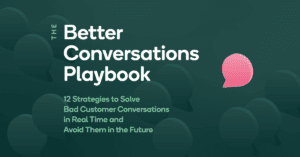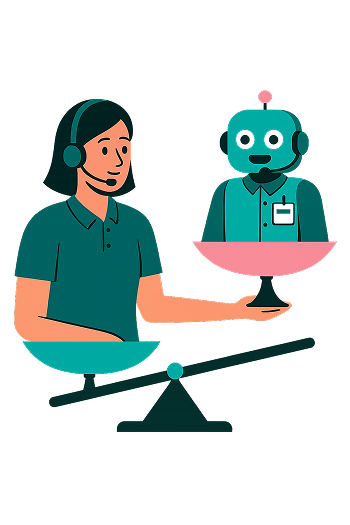Nowadays, customers expect top-tier customer service. High-quality customer experiences are table stakes today for brands of all stripes. But that doesn’t make delivering them easy.
The increase in real-time accessibility has driven these high expectations, as well as the shift to digital channels during COVID. Today, 38% of consumers are more likely to buy from a company that offers live chat support. And 79% of customers say they prefer live chat over phone, email, or in-person communication purely because of its immediacy.
Equally, experience expectations have continued to rise because customers have real-time access to brands through various digital channels. Some brands have publicly staked their claim on being good at customer service (e.g., Zappos, Chewy), providing quality that other companies must meet to keep their customers happy and loyal.
However, according to the national American Customer Satisfaction Index, customer satisfaction across the U.S. is declining. Customer satisfaction dropped 0.5% to 73.3% (out of 100) in Q4 2021, the lowest score since 2005. So, what is hindering customer service reps from providing excellent customer service today?
The Customer Conversations Conundrum: Efficiency vs. Empathy
When providing good customer service, speed is critical. That doesn’t mean speed is the only thing that matters. Customers want brands to care and treat them like human beings.
Many companies have turned to chatbots to reduce the overhead costs of customer service.
However, while the rapid innovation of chatbots enables them to handle complex requests efficiently, bots just don’t have the same emotional capabilities as humans. Some customer conversations are too difficult, specific, or emotionally charged for a bot to handle.
Plus, many customers simply want to have human interaction after many frustrating experiences with interactive voice response (IVRs) and poorly programmed chatbots. With $4.7 trillion in global consumer sales at risk from bad conversations, there’s a lot at stake if brands don’t take action and improve their customer service experiences.
Brands can leverage chatbots as part of their overall customer service strategy, but they have to be strategic about when to loop in humans or more sophisticated technologies. Automation can handle simple customer service requests like password resets or FAQs. But an inquiry that is too much for a bot to process should be quickly routed to a human customer service agent before it escalates.
While chatbots have come a long way, they will always have limitations.
A Tough Job, But Someone’s Gotta Do It
We can see that chatbots aren’t always the solution, and agents must handle at least some customer conversations. So the question becomes, “How do brands determine which customer conversations need to be routed to agents, and how can we support them appropriately?”
A critical fact: Customer service agents’ jobs are very challenging, and they are often handling large volumes of chats. They may not be working in their native language, so it can be difficult to quickly understand the sentiment of the customer conversation and respond most appropriately.
Often, agents aren’t properly trained and may not have a “library” of appropriate responses for all situations (especially emotionally charged situations). Turnover can be high in call centers / BPOs because agents’ jobs are tiring, and many burn out after too much time spent being “yelled at” by disgruntled customers. Plus, ensuring agents get the most up-to-date information when policies change can be challenging.
We know that this list of complications makes it seem like preparing your customer service agents to provide high-quality customer conversations is more trouble than it’s worth. But, bad conversations are much more damaging to a brand than most people realize.
Bad Customer Conversations are Too Dangerous to Overlook
Customer conversations that go south can affect your customers’ loyalty, your brand’s reputation, and ultimately, your revenue.
Customer Loyalty and Retention
A whopping 97% of global consumers say customer service is an essential factor in their choice of or loyalty to a brand, and 81% of customers say a positive customer experience makes them more likely to make another purchase.
Plus, 61% of consumers say they would switch to a company’s competitor after just one bad customer service experience. This means every business must take customer service interactions seriously and develop strategies to avoid bad conversations.
Brand Reputation
In the age of social media, negative experiences can go viral in a heartbeat.
“When you have a bad experience, you don’t just tell your friends… you tell everyone!” – Etie Hertz, CEO of Loris.
The average customer tells at least 15 people about any negative customer service experience, and if they have a positive experience, they only tell six people. Unhappy customers also post on social media, leave negative reviews, and rate the product poorly, publicly affecting a brand’s reputation.
The Bottom Line
Businesses lose $75 billion a year due to poor customer service. A significant factor in this is when a company does not prioritize empathy in its customer service; this alone costs the average brand $300 million in lost revenue every year. Our takeaway? Bad customer conversations are bad for business.
Ready to Stop Bad Customer Conversations?
While some bad conversations are going to happen no matter what you do, many can be prevented, turned around, or — at the very least — used as a learning opportunity to avoid future missteps. Learning how to turn bad conversations into better ones (ideally good ones!) will help increase customer satisfaction rates, brand loyalty, and your overall bottom line.
Our brand new guide, The Better Conversations Playbook: 12 Proven Strategies to Solve Bad Conversations in Real Time and Avoid Them in the Future, highlights the three key stages in the customer service lifecycle when brands can impact the quality and outcomes of conversations.
Read the whole playbook to gain valuable strategies to help your brand improve customer service outcomes today.


